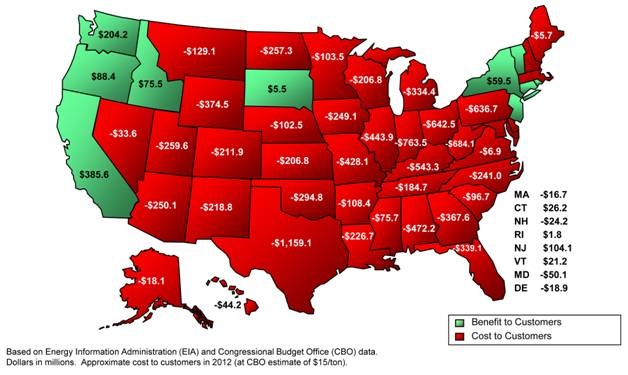The Obama administration this week released a 196-page plain-language report that describes predicted future impacts of climate change on the U.S. The report comes during a week of inconclusive negotiation among key House lawmakers on climate legislation, and as the Senate Energy and Natural Resources Committee passes what could be the third energy bill in four years. “Green jobs” start to wear a human face.
The Authoritative Assessment of National, Regional Impacts of Global Climate Change documents predictions and changes already observed in the U.S. and around the world, including higher temperatures, “reduced frost days, increased frequency and intensity of heavy downpours, a rise in sea level, and reduced snow cover, glaciers, permafrost, and sea ice.” Many concerns come down to the idea that people are predicted to find themselves living in the wrong place. “It is difficult and expensive to alter or replace infrastructure designed to last for decades (such as buildings, bridges, roads, airports, reservoirs, and ports) in response to continuous and/or abrupt climate change,” the report states.
The Guardian reports that a San Francisco media consultancy oversaw release of the Authoritative Assessment. The document is “scrubbed of the usual scientific jargon,” and its release is timed to support the climate bill in the House. That the White House had outside media help on a major climate report might be seen either as a crutch or as a breakthrough. Either way, many scientists have long had a disadvantage in communicating their work and findings, in part because professional standards and practices differ rather wildly from both traditional media and what might be called “normal” human interpersonal communication. Science talk — climate-science talk notoriously — is marked by circumspection, caveats, technical descriptions of physical evidence, and statistical and probabilistic mathematics. Efforts are underway to humanize public climate communication, including the fruits of behavioral research and a recent deep dive into how each of the “Six Americas” [pdf] understand climate change.
In Europe, the climate may already be morphing along two paths. The European Union body charged with protecting the Alps released its second report, documenting bifurcation in the climate of Europe. North of the Matterhorn and Mont Blanc, Europeans are seeing more flooding and mud slides. Southeastern Alpine communities report a drop in rainfall — 10 percent over the last century. Marco Onida, head of the Alpine body: “The Alps are the water tower of Europe. But increasingly much of the water is not reaching the places downstream where it is needed, for ecosystems, agriculture and energy production.”
What we talk about when we talk about climate: The NYT Magazine lays bare the device — of climate change and many other issues — with the day-glo orange headline “INFRASTRUCTURE!* (*It’s more exciting than you think, actually).” The stories have nothing to do with climate change, save a few references to post-Kyoto Paris. But focusing attention to inspiring, high-functioning replacements for decaying infrastructure would serve a number of issues. Every week, the climate press tries to do more subtly what the NYT hit directly last weekend. “Rebuilding infrastructure” might be one way to organize many of the most consequential story trends of the day — if there were a nicer word for it. As the White House science assessment suggests, climate change might leave much of our current infrastructure might in the wrong place.
Infrastructure change can be local and quiet. The governor of Kolkata, India, undertook an energy-savings program at his 27-acre residence, formerly the seat of the British Empire in India. The actions cut the government’s electricity bill by 15 percent and CO2 emissions from electricity by 18 percent. Nearly 80 percent of the reductions came from behavioral change. Governor Gopalkrishna Gandhi told the Times of India that his grandfather–Mahatma Gandhi–spoke frequently and at length about proper levels of consumption.
Infrastructure change can also be both monumental — and an experiment. The Wall Street Journal takes on “geo-engineering” — cooling the atmosphere through large-scale projects, such as the release of reflective sulfate aerosols, cloud farming, or Climate Post suggests, ask the artist Christo to wrap the poles in reflective Mylar. The Washington Post runs a geo-engineering op-ed by Samuel Thernstrom of the American Enterprise Institute, also pegged to a National Academy of Sciences conference on the subject.
Personal and community efforts, geo-engineering projects, and even national laws in and of themselves will not prevent dangerous manmade warming, but all of them, aggregated, would be powerful, according to number-crunching (and Chinese Politburo satire) at the Green Grok.
Can’t see the forest through the hyperlinks: Many people familiar with climate change know that deforestation is responsible for about 20 percent of the increase in greenhouse gases. Major media have shown increased interest in deforestation’s contribution to global warming, particularly efforts to fund rainforest conservation through global carbon credit markets. A recent New York Times editorial supported inclusion of forest measures left out of the 1997 Kyoto Protocol. The Economist looks seriously and critically at the issue, pointing out its promise — keeping forests in tact may be the simplest way to reduce greenhouse gases — and its difficulty — the world community’s interest in saving rainforests conflicts with local economic incentives. [The Nicholas Institute just published a comprehensive package explaining the issues, options, and economics for global forest efforts.]
The rainforest story this week stretches from pristine Cameroon ecosystems to global financial centers. Mongabay learns that a 3,200-sq. mi. Cameroon rainforest will be gutted in 30 days for logging and iron mining, its recently documented population of lowland gorillas, elephants, mandrills, and chimpanzees dislocated and left to die, unless conservationists can find project financing. “We have 30 days,” a conservationist working on the issue said. “It’s a race against time.” (Cameroon to elephants: “Gimme your wallet–or else…”) Large British investment houses are throwing their support behind greater disclosure in financial documents of firms’ roles in deforestation, Reuters reports. The Forest Footprint Disclosure Project is designed to encourage Fortune 500 companies to account for increasing financial risks associated with reducing forest cover. A Financial Times blog post explains forests’ plight in the context of what you had for breakfast.
Two men who have never met: Two stories this week together demonstrate what might be called the climate gap, or the difference in comfort levels with climate science that scientists and observers have and, well, most everyone else. A NYT overview of the synthesis report concludes with Michael MacCracken, a lead author of the previous U.S. assessment and adviser to the current one, saying, “There is not much that is new.” Yet this piece from the Deseret News suggests that scientific assessments are far from universally read and accepted. Utah Lt. Gov. Gary Herbert tells a Western Governors Association panel, “I’ve heard people argue on both sides of the issue, people I have a high regard for. People say man’s impact is minimal, if at all, so it appears to me the science is not necessarily conclusive… What are we doing to bring people together? Is there a hidden agenda out there? Help me understand the science.”
The Climate Post offers a rundown of the week in climate and energy news. It is produced each Thursday by Duke University’s Nicholas Institute for Environmental Policy Solutions.



